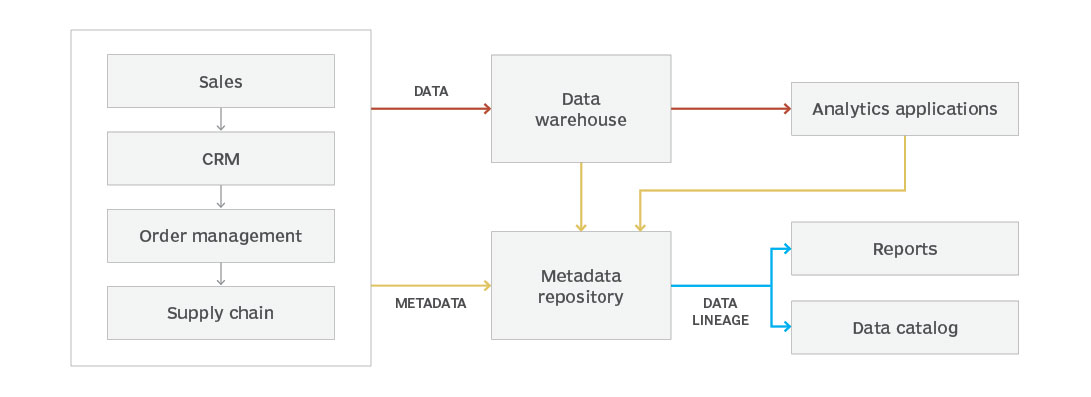Webpage

Building a Data Lineage Framework: Tips and Tools for Success
In today's business landscape, data is the backbone of every enterprise. It penetrates every facet of an organization, and without it, operating even the most rudimentary business functions may become hugely challenging. However, with the exponential growth of data, it's easy to lose sight of its journey, transformation, and final destination - leaving data teams struggling with visibility and clarity. According to Forbes, the volume of data is expected to reach a staggering 181 zettabytes by 2025, bolstering the need for a robust lineage strategy.
A data lineage strategy acts as a trusted guide, providing critical details about data. It ensures that stakeholders have legitimate data for all their decision-making. A strong data lineage strategy is essential for organizations to gain transparency and control over their data.
What is Data Lineage?
IBM defines data lineage as the process of tracking the flow of data over time, providing a clear understanding of where the data originated, how it has changed, and its ultimate destination within the data pipeline. Data lineage tracks data through each system, from extraction to ingestion to consumption. The data lineage process starts by collecting data in operational systems and storing them in data warehouses and lakes intended for analytics and BI applications. Metadata is then stored in a central repository or lineage tool that provides details about the data, such as its source, format, content, and the transformations involved in processing it. Lineage information is often incorporated into data catalogs to make it easier for end-users to access and understand how data has moved through various systems and processes.
Why is Data Lineage Important?
Consider what would happen if data errors went undetected. These errors have the potential to create numerous challenges for organizations. For instance, inaccurate or inconsistent analytics results may ensue, which can lead to flawed decision-making, ultimately impacting a company's bottom line.
Therefore, data lineage is the cornerstone of successful data management and analytics in today's data-driven world. It sheds light on sources of errors and anomalies, thus helping improve data quality. In addition, tracking the origin and flow of data enables organizations to unlock untapped business potential while ensuring that data privacy and protection regulations are met.
Data Lineage Best Practices
The choice of lineage techniques primarily depends on an organization's unique application requirements and data environment. To maintain the accuracy and usefulness of data lineage processes, consider implementing the following tips:
Invest in the right tools:
Selecting a platform one that aligns with enterprise objectives and is compatible with the existing technology stack is vital. A suitable tool can help capture metadata precisely, provide specific lineage visualization, and simplify maintaining and updating the lineage model.
Develop a comprehensive data lineage model:
Developing a comprehensive data lineage model is essential to capture a holistic view of data flows, including data sources, models, transformations, and quality metrics. This will enable businesses to deeply understand their data, including the business context and relationships between different data elements. Such an understanding will help organizations make data-driven decisions that yield significant insights, improve operational efficiency, and enhance business outcomes.
Set the stage for success:
Clear objectives are key to implementing a data lineage program. This entails deciding which data to track, what metadata to capture, and how the lineage information will be utilized. Defining objectives from the start ensures that the data lineage program is tailored to the specific needs and goals of the organization.
Capture all metadata:
For a complete and accurate data lineage model that provides a comprehensive picture of data flows, it is essential to capture all metadata. Metadata encompasses critical information such as data source, data type, transformations, and data quality metrics, which helps to better understand the context of data lineage.
Establish data quality controls:
Setting up data quality controls is vital to ensuring the effectiveness of a data lineage initiative. These controls, which may include data validation rules and quality checks, enhance the data's accuracy and consistency, thereby enhancing the reliability of the lineage information and ultimately enabling better decision-making.
Implement data lineage track5ing:
Gain complete visibility into data flow by implementing data lineage tracking. Ensure to automatically capture data lineage by integrating data lineage tools with data processing systems like ETL/ELT, Kafka, and ML frameworks. This helps with making informed decisions and safeguarding your organization from data errors.
Maintain data lineage:
One key to a successful data lineage program is keeping the lineage information current. This involves regularly monitoring and updating metadata and ensuring that changes to data sources and systems are accurately reflected in the lineage model. By maintaining data lineage in this way, organizations can ensure that the information remains reliable and relevant, providing valuable insights for effective decision-making.
Encourage collaboration:
Fostering collaboration between data teams, business stakeholders, and IT teams is crucial for the success of a data lineage initiative. This promotes alignment of the lineage information with business objectives and facilitates the identification and resolution of gaps and inconsistencies in the lineage model.
7 Best Data Lineage Platforms in 2023
Various data lineage tools are present in the market, and selecting the best one hinges on the organization's specific needs and requirements. Some widely used data lineage tools are:
1. Apache Atlas:
An open-source data governance and metadata framework that provides a scalable and extensible solution for capturing and managing metadata and lineage information for Hadoop-based data platforms.
2. Collibra:
A cloud-based data governance platform that helps organizations manage and govern their data assets by providing end-to-end data lineage, cataloging, and data quality capabilities.
3. Alation:
It provides a range of features such as data cataloging, data lineage, data quality, and data discovery.
4. Informatica:
It includes data lineage capabilities that allow organizations to track the data movement across their systems.
5. Talend:
An open-source data integration platform that offers a range of tools for managing and integrating data across multiple sources. It includes data lineage capabilities that allow organizations to track the data flow across their systems.
6. MANTA:
A data lineage platform that provides end-to-end visibility into data flows across an organization's systems. It supports a range of data platforms, including relational databases, big data platforms, and ETL tools.
7. Octopai:
Octopai Data Lineage is a powerful tool that provides end-to-end visibility into your data landscape. It offers three different layers of data lineage: cross-system lineage, end-to-end column lineage, and inner-system lineage. This allows you to track the flow of data from its source to its destination, identify potential problems, and improve the quality of your data.
Conclusion
A streamlined data lineage process that promotes transparency and understanding can unlock the power of any data ecosystem. Enterprises can confidently make strategic business decisions by having granular-level visibility into data throughout its lifecycle. Take advantage of the potential benefits of effective data lineage - start optimizing the business process.
If you're looking to gain a deeper understanding of your organization's data and ensure its accuracy and compliance, our team of data experts can help. Reach out to the Data Management and Analytics practitioners at Intelliswift to learn more about how we are helping customers solve industry-wide challenges with siloed data, data quality and compliance by leveraging AI-assisted tools from partners like Informatica and Octopai.



